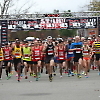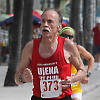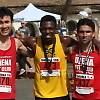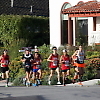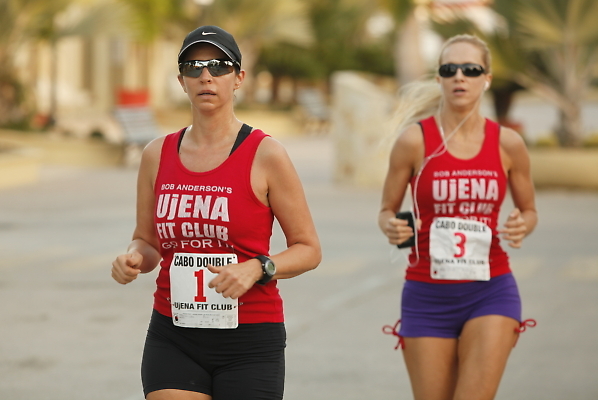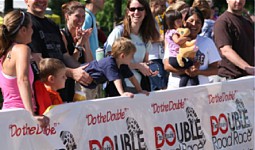UjENA FIT Club 100 Interesting Running Articles
Best Road Races and the UjENA FIT Club is publishing 100 articles about races, training, diet, shoes and coaching. If you would like to contribute to this feature, send an email to Bob Anderson at bob@ujena.com . We are looking for cutting edge material.
Click here to read all Running Articles
Posted Wednesday, February 11th, 2015
By David Prokop Pleasanton, Calif., may be a quiet, relaxed community across the bay from San Francisco, but where Double... Read Article
Posted Monday, September 15th, 2014
Peter Mullin has taken Double Racing® by storm. He broke the 60-64 age group world record in the first Double... Read Article
Posted Monday, September 22nd, 2014
by David Prokop (Editor Best Road Races) Photo: Double 15k top three Double Racing® is a new sport for... Read Article
Posted Sunday, May 11th, 2014
By David Prokop, editor Best Road Races The world’s most unusual race met the world’s most beautiful place, in the... Read Article
The Double - Race Strategy Part 2
Tuesday, October 30th, 2012
A ROAD RUNNER’S CHESS MATCH
by Dave Prokop (Second of a four part article) If we whetted your appetite with the first 10 strategies offered last week in Part One of this tactical analysis of the Double Road Race™, here are another 10 possible strategies for you to consider (and, dare we say it, digest?). Next week – in Part Three – we’ll list another 10 strategies, followed the week after that – in Part Four – by still another 10! Well, we did warn you that there are almost an endless number of strategy variations possible in the Double. The top three leaders at the recent Cabo Double Oct 27. Javier (bib 12) ran the 10th best time ever posting 53:58 (36:04 10k and 17:54 5k legs) 12. THE BOB ANDERSON STRATEGY -- During his campaign to run 50 races this year in celebration of his 50 years of running, Bob Anderson, who created the Double, set as his goal to average under seven minutes per mile for the entire series of races. Depending on a runner's ability level, a worthy strategy (and goal) in the Double might be to average under seven minutes per mile for both the 10K and 5K legs. In terms of time, that translates to running the 10K in under 43:19 and the 5K in under 21:52, for an aggregate time under 65:11. Anyone who sets out to do that at the Pleasanton Double should have the honor of running somewhere close to Bob Anderson, who will be attempting to do just that in both legs -- average under seven minutes a mile for each. Bob Anderson (bib 50) ran 66:38 at the Cabo Double. 13. THE DOUBLE KICK STRATEGY -- A distance runner who really has a great finishing kick may choose to simply follow the leader(s) whatever the pace may be (and to this kind of runner, the slower the pace the better), then just outkick everybody at the end of the 10K leg and again at the end of the 5K. Wouldn't we all like to be in a position to do that? 14. THE NO-STRATEGY STRATEGY -- You go into the Double with no set strategy. All you plan to do is listen for the starting gun, go out at whatever pace suits your fancy at the moment, react to what happens around you and within you, improvise, shed yourself of all expectations, experience the experience. My old friend Ian Jackson, runner, writer, teacher and yoga afficionado, would no doubt use this strategy -- and probably finish near the front of the field in his age group. Comments and Feedback
 Some more good Double reading...thanks Dave and I can not wait to read your next 10 strategies... Some more good Double reading...thanks Dave and I can not wait to read your next 10 strategies...Bob Anderson 10/30/12 10:19 pm |
,,,,, | 15. THE ROLL-THE-DICE STRATEGY -- Run the 10K hard, maybe to your limit, to hopefully build a good lead over your main competitors and your peers, establish a solid foundation for a great aggregate time, then trust in your conditioning, your recoverability (a key word in the Double, you'll notice) and your willpower to see you through the 5K. This approach takes guts, faith and perhaps a conviction that, “Hey, after the 10K and a rest break, the 5K should feel like nothing, even if I am tired. If I can't hang in there for 5K on guts alone to run a respectable time, I don't deserve to be called a distance runner, do I?" 16. THE GRAND EXPERIMENT STRATEGY -- See the Double as one competition in a series of Doubles you plan to run. Experiment in each successive Double how hard a pace you can handle in the 10K and the 5K with the rest in between. Then you'll be seeking to go faster from one competition to the next as you get the feel and pacing of the competition more ingrained in your mind, as your training becomes more specific and effective for the challenge involved, and as you learn to improve your recoverability during the rest break. 17. THE I-WISH-I-HAD-TRAINED-HARDER-FOR-THIS-DAMNED-THING STRATEGY -- In this strategy you start slow and expect to finish slower. You're not really in good shape for the competition, and even before you complete the 10K, you start paying the price for not training hard enough -- or maybe you get through the 10K alright, but your lack of conditioning really hits you hard when you get back on the road after the rest break to do the 5K. What you do in that situation is apply the I-Wish-I-Had-Trained-Harder Strategy, which is gear back, keep putting one foot in front of the other until you reach the finish line, and promise yourself you'll prepare better the next time. Never give up or drop out, unless you're at risk of injuring yourself. Finishing when you're feeling rotten is a victory in itself, which you can build on in terms of willpower the next time you compete. Remember, there's physical conditioning and there's mental toughness, and whether you realize it or not you're working on both (or should be) every time you lace up your running shoes and do a training run or run a race. Javier from Cabo went for it and posted the tenth best time ever at the recent Double held in San Jose del Cabo Oct 27. 18. THE RUNNING-TO-BREAK-THE-RECORD STRATEGY -- The Double, as a competition, is still in its infancy, so there is no real history of records and, as yet, no tradition of competitors really going after them. But that will change. When it does, it is inevitable that accomplished runners will be applying this strategy and everything it entails. Running to break a record is essentially running against a stopwatch rather than against your competition. Of course, the challenge of setting a new record in the Double is more subtle and tricky than in a normal distance race. 19. THE PRETEND-THERE'S-NO-5K STRATEGY -- When you stand at the starting line and the gun goes off, race the 10K as if that's all you're going to do for the day. If you run the 10K under 40 minutes, you'll have one hour to recover before the 5K is called to the line (typically the 5K in the Double starts 100 minutes, give or take a few minutes, after the start of the 10K – not the finish of the 10K, the start). And what's the worst that can happen if you run too fast in the 10K? You'll run a lousy 5K. But then again, maybe not. Most runners can't push themselves to a state of complete and utter exhaustion even if they raced the 10K all out; they simply don't have the mental toughness to push themselves through the discomfort involved. They may not be able to run any faster or harder, but are they utterly exhausted? Not likely. That being the case, and the fact there's a rest break after the 10K, it may very well be that most runners may find they can recover sufficiently to run a decent 5K even if they did run as hard as they could in the 10K. It should be remembered, too, that the 5K is only half the distance already covered in the opening leg. 20. THE MANO-A-MANO STRATEGY – Often in a distance race it comes down to a battle between two runners who are superior to everyone else. This could and probably will happen in the Double as well. When it happens, the strategy becomes obvious: Just race the man – or woman, if the two runners involved happen to be women. |

Copyright 2025 UjENA Swimwear · Site Map · Feedback · Tell A Friend · Nominate a Race
Leaderboard · UjENA 5K · Double Road Race · UjENA Jam · UjENA Network









